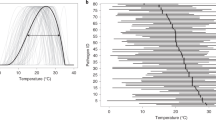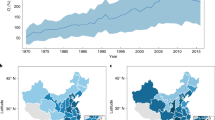Abstract
Global food security is threatened by the emergence and spread of crop pests and pathogens. Spread is facilitated primarily by human transportation, but there is increasing concern that climate change allows establishment in hitherto unsuitable regions. However, interactions between climate change, crops and pests are complex, and the extent to which crop pests and pathogens have altered their latitudinal ranges in response to global warming is largely unknown. Here, we demonstrate an average poleward shift of 2.7±0.8 km yr−1 since 1960, in observations of hundreds of pests and pathogens, but with significant variation in trends among taxonomic groups. Observational bias, where developed countries at high latitudes detect pests earlier than developing countries at low latitudes, would result in an apparent shift towards the Equator. The observed positive latitudinal trends in many taxa support the hypothesis of global warming-driven pest movement.
This is a preview of subscription content, access via your institution
Access options
Subscribe to this journal
Receive 12 print issues and online access
$209.00 per year
only $17.42 per issue
Buy this article
- Purchase on Springer Link
- Instant access to full article PDF
Prices may be subject to local taxes which are calculated during checkout




Similar content being viewed by others
References
Flood, J. The importance of plant health to food security. Food Secur. 2, 215–231 (2010).
Fisher, M. C. et al. Emerging fungal threats to animal, plant and ecosystem health. Nature 484, 186–194 (2012).
Strange, R. N. & Scott, P. R. Plant disease: A threat to global food security. Annu. Rev. Phytopathol. 43, 83–116 (2005).
Oerke, E-C. Crop losses to pests. J. Agric. Sci. 144, 31–43 (2006).
Chakraborty, S. & Newton, A. C. Climate change, plant diseases and food security: An overview. Plant Pathol. 60, 2–14 (2011).
Anderson, P. K. et al. Emerging infectious diseases of plants: Pathogen pollution, climate change and agrotechnology drivers. Trends Ecol. Evol. 19, 535–544 (2004).
Stukenbrock, E. H. & McDonald, B. A. The origins of plant pathogens in agro-ecosystems. Annu. Rev. Phytopathol. 46, 75–100 (2008).
Brown, J. K. M. & Hovmøller, M. S. Aerial dispersal of pathogens on the global and continental scales and its impact on plant disease. Science 297, 537–541 (2002).
Singh, R. P. et al. The Emergence of Ug99 races of the stem rust fungus is a threat to world wheat production. Annu. Rev. Phytopathol. 49, 465–481 (2011).
Hovmøller, M. S., Yahyaoui, A. H., Milus, E. A. & Justesen, A. F. Rapid global spread of two aggressive strains of a wheat rust fungus. Mol. Ecol. 17, 3818–3826 (2008).
Cooke, D. E. L. et al. Genome analyses of an aggressive and invasive lineage of the Irish potato famine pathogen. PLoS Pathog. 8, e1002940 (2012).
Koricheva, J., Larsson, S. & Haukioja, E. Insect performance on experimentally stressed woody plants: a meta-analysis. Annu. Rev. Entomol. 43, 195–216 (1998).
Bale, J. S. et al. Herbivory in global climate change research: direct effects of rising temperature on insect herbivores. Glob. Change Biol. 8, 1–16 (2002).
Woods, A. Is the health of British Columbia’s forests being influenced by climate change? If so, was this predictable? Can. J. Plant Pathol. 33, 117–126 (2011).
Mauch-Mani, B. & Mauch, F. The role of abscisic acid in plant–pathogen interactions. Curr. Opin. Plant Biol. 8, 409–414 (2005).
Huber, L. & Gillespie, T. J. Modeling leaf wetness in relation to plant disease epidemiology. Annu. Rev. Phytopathol. 30, 553–577 (1992).
Garrett, K. A., Dendy, S. P., Frank, E. E., Rouse, M. N. & Travers, S. E. Climate change effects on plant disease: genomes to ecosystems. Annu. Rev. Phytopathol. 44, 489–509 (2006).
Gregory, P. J., Johnson, S. N., Newton, A. C. & Ingram, J. S. I. Integrating pests and pathogens into the climate change/food security debate. J. Exp. Bot. 60, 2827–2838 (2009).
Shaw, M. W. & Osborne, T. M. Geographic distribution of plant pathogens in response to climate change. Plant Pathol. 60, 31–43 (2011).
Parmesan, C. & Yohe, G. A globally coherent fingerprint of climate change impacts across natural systems. Nature 421, 37–42 (2003).
Burrows, M. T. et al. The pace of shifting climate in marine and terrestrial ecosystems. Science 334, 652–655 (2011).
Chen, I-C., Hill, J. K., Ohlemüller, R., Roy, D. B. & Thomas, C. D. Rapid range shifts of species associated with high levels of climate warming. Science 333, 1024–1026 (2011).
Furman, J. L., Porter, M. E. & Stern, S. The determinants of national innovative capacity. Res. Policy 31, 899–933 (2002).
Devictor, V. et al. Differences in the climatic debts of birds and butterflies at a continental scale. Nature Clim. Change 2, 121–124 (2012).
Hoegh-Guldberg, O. et al. Assisted colonization and rapid climate change. Science 321, 345–346 (2008).
Reilly, J. et al. US agriculture and climate change: New results. Climatic Change 57, 43–67 (2003).
Clavero, M., Villero, D. & Brotons, L. Climate change or land use dynamics: Do we know what climate change indicators indicate? PLoS ONE 6, e18581 (2011).
Schmidhuber, J. & Tubiello, F. N. Global food security under climate change. Proc. Natl Acad. Sci. USA 104, 19703–19708 (2007).
Lobell, D. B. et al. Prioritizing climate change adaptation needs for food security in 2030. Science 319, 607–610 (2008).
Pasiecznik, N. M. et al. CABI/EPPO distribution maps of plant pests and plant diseases and their important role in plant quarantine. Eppo Bull. 35, 1–7 (2005).
Acknowledgements
The authors thank Earthwatch and the HSBC Climate Partnership for financially supporting D.P.B.
Author information
Authors and Affiliations
Contributions
M.A.T.R. collected the data, D.P.B. analysed the data and following discussion with S.J.G., D.P.B. and S.J.G. wrote the paper.
Corresponding author
Ethics declarations
Competing interests
The authors declare no competing financial interests.
Supplementary information
Rights and permissions
About this article
Cite this article
Bebber, D., Ramotowski, M. & Gurr, S. Crop pests and pathogens move polewards in a warming world. Nature Clim Change 3, 985–988 (2013). https://doi.org/10.1038/nclimate1990
Received:
Accepted:
Published:
Issue Date:
DOI: https://doi.org/10.1038/nclimate1990
This article is cited by
-
Key role of environmental competence in successful use of entomopathogenic fungi in microbial pest control
Journal of Pest Science (2024)
-
Assessing the impact of climate-resilient maize varieties and their interaction with the stem borer chilo partellus (swinhoe) (lepidoptera: crambidae) in semi-field conditions
International Journal of Tropical Insect Science (2024)
-
Early warning and management of invasive crop pests under global warming: estimating the global geographical distribution patterns and ecological niche overlap of three Diabrotica beetles
Environmental Science and Pollution Research (2024)
-
Climate change impacts on crop yields
Nature Reviews Earth & Environment (2023)
-
Address the growing urgency of fungal disease in crops
Nature (2023)



